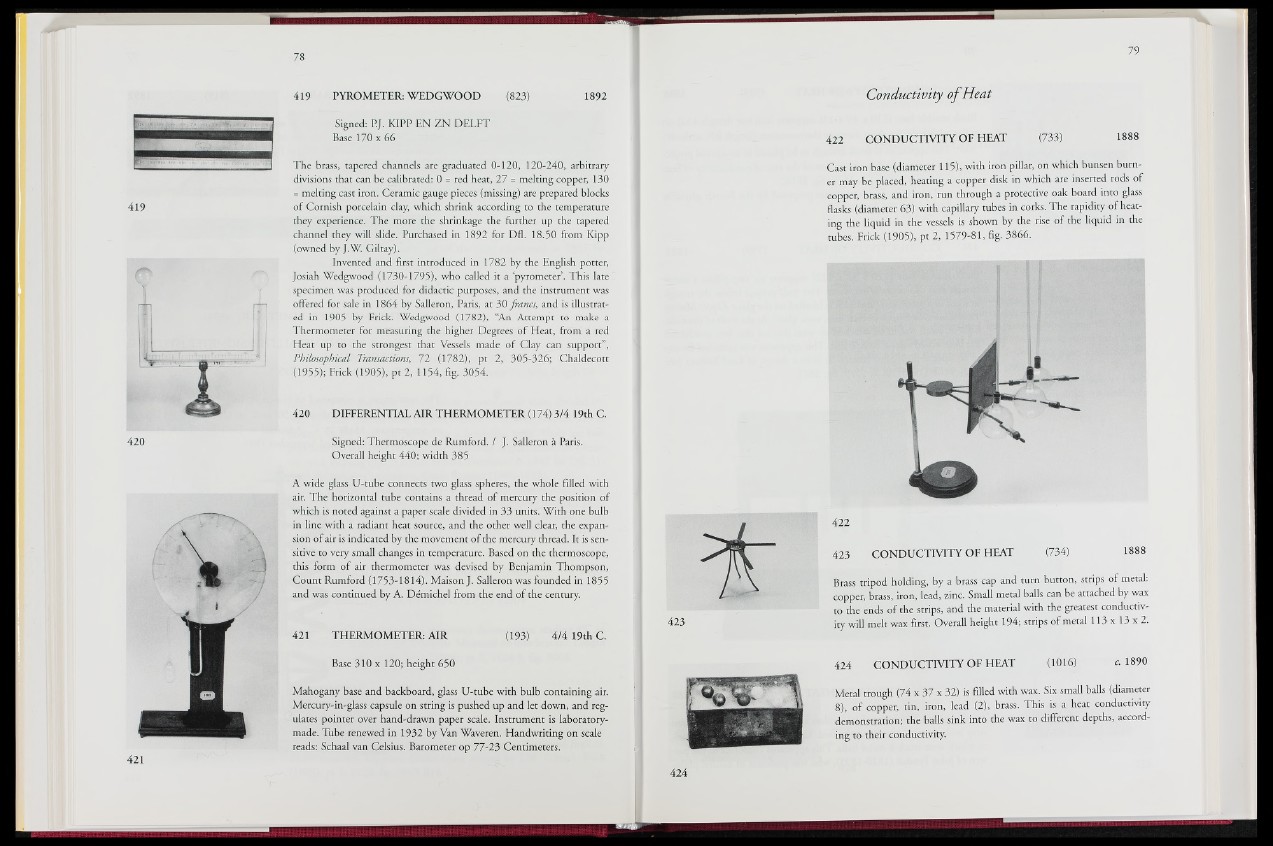
419 PYROMETER: WEDGWOOD (823) 1892
419
ffl
V
420
Signed: P.J. KIPP EN ZN DELFT
Base 170 x 66
The brass, tapered channels are graduated 0-120, 120-240, arbitrary
divisions that can be calibrated: 0 = red heat, 27 = melting copper, 130
= melting cast iron. Ceramic gauge pieces (missing) are prepared blocks
of Cornish porcelain clay, which shrink according to the temperature
they experience. The more the shrinkage the further up the tapered
channel they will slide. Purchased in 1892 for Dfl. 18.30 from Kipp
(owned by J.W. Giltay).
Invented and first introduced in 1782 by the English potter,
Josiah Wedgwood (1730-1795), who called it a ‘pyrometer. This late
specimen was produced for didactic purposes, and the instrument was
offered for sale in 1864 by Salleron, Paris, at 30 francs, and is illustrated
in 1905 by Frick. Wedgwood (1782), “An Attempt to make a
Thermometer for measuring the higher Degrees of Heat, from a red
Heat up to the strongest that Vessels made of Clay can support”,
Philosophical Transactions, 72 (1782), pt 2, 305-326; Chaldecott
(1955); Frick (1905), pt 2, 1154, fig. 3054.
420 DIFFERENTIAL AIR THERMOMETER (174) 3/4 19th C.
Signed: Thermoscope de Rumford. / J. Salleron a Paris.
Overall height 440; width 385
A wide glass U-tube connects two glass spheres, the whole filled with
air. The horizontal tube contains a thread of mercury the position of
which is noted against a paper scale divided in 33 units. With one bulb
in line with a radiant heat source, and the other well clear, the expansion
of air is indicated by the movement of the mercury thread. It is sensitive
to very small changes in temperature. Based on the thermoscope,
this form of air thermometer was devised by Benjamin Thompson,
Count Rumford (1753-1814). Maison J. Salleron was founded in 1855
and was continued by A. Demichel from the end of the century.
421 THERMOMETER: AIR
Base 310 x 120; height 650
(193) 4/4 19th C.
Mahogany base and backboard, glass U-tube with bulb containing air.
Mercury-in-glass capsule on string is pushed up and let down, and regulates
pointer over hand-drawn paper scale. Instrument is laboratory-
made. Tube renewed in 1932 by Van Waveren. Handwriting on scale
reads: Schaal van Celsius. Barometer op 77-23 Centimeters.
ü
Conductivity o f Heat
422 CONDUCTIVITY OF HEAT (733) 1888
Cast iron base (diameter 115), with iron pillar, on which bunsen burner
may be placed, heating a copper disk in which are inserted rods of
copper, brass, and iron, run through a protective oak board into glass
flasks (diameter 63) with capillary tubes in corks. The rapidity of heating
the liquid in the vessels is shown by the rise of the liquid in the
tubes. Frick (1905), pt 2, 1579-81, fig. 3866.
422
423 CONDUCTIVITY OF HEAT (734) 1888
Brass tripod holding, by a brass cap and turn button, strips of metal:
copper, brass, iron, lead, zinc. Small metal balls can be attached by wax
to the ends of the strips, and the material with the greatest conductivity
will melt wax first. Overall height 194; strips of metal 1 1 3 x 1 3 x 2 .
424 CONDUCTIVITY OF HEAT (1016) r. 1890
Metal trough (74 x 37 x 32) is filled with wax. Six small balls (diameter
8), of copper, tin, iron, lead (2), brass. This is a. heat conductivity
demonstration; the balls sink into the wax to different depths, according
to their conductivity.